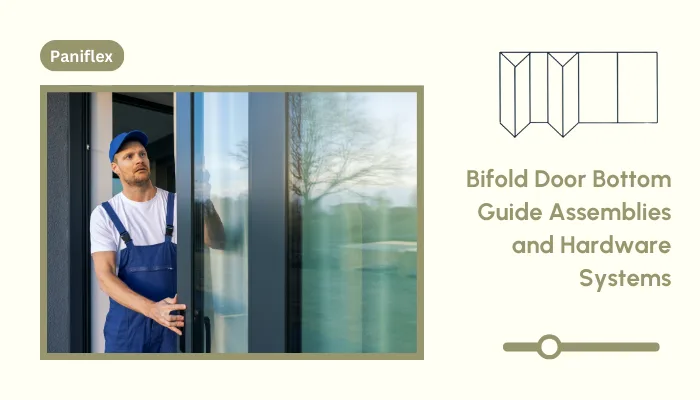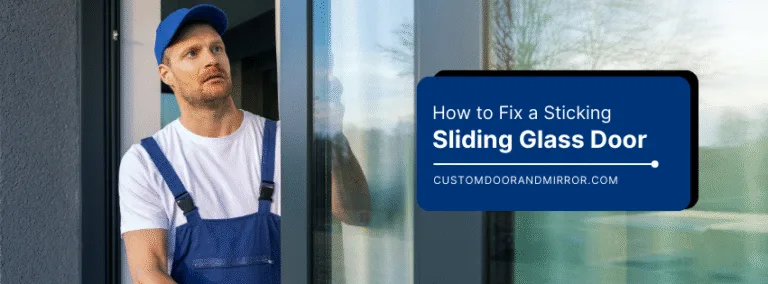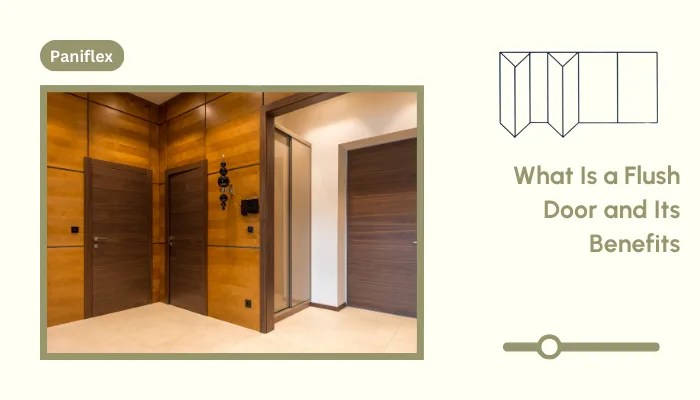Bifold doors are commonly chosen for their ability to provide a smooth, reliable solution for high-traffic areas. However, they require the right hardware systems for optimal performance and longevity.
Bottom guide assembly is important for maintaining proper alignment, smooth movement, and extending the lifespan of the doors. A well-designed and maintained bottom guide assembly can significantly enhance the door’s performance.
On the other hand, a malfunctioning system can lead to issues like misalignment, noise, and difficulty in operation.
This guide will delve into the importance of bifold door bottom guide assemblies. We will also explore their key components, selection criteria, and maintenance practices to ensure optimal door longevity.
What is a Bifold Door Bottom Guide Assembly?
The bottom guide assembly is a necessary component in the operation of bifold doors, ensuring that the door panels move smoothly and remain aligned within the track system. It plays a significant role in stabilizing the doors and preventing them from swinging.
Without a properly functioning bottom guide, even the most carefully installed bifold doors can experience issues. This includes difficulty in operation, excessive wear, or premature failure.
These are a few things that bottom guides do for your bifold doors:
- Ensures door panels stay aligned during operation
- Prevents misalignment and swinging
- Provides smooth movement along the track
- Reduces wear on other components like rollers and tracks
- Essential for long-term door durability and performance
A bottom guide assembly is made up of several key components that work together to ensure smooth, reliable operation of bifold doors. Each part plays a specific role in maintaining alignment, reducing friction, and ensuring long-lasting performance.
You can better appreciate how they contribute to the overall efficiency of the bifold door system by understanding the individual components.
Recommended Watch: This video gives a step-by-step tutorial on how to install bifold doors.
Key Components of Bottom Guide Assemblies
The bottom guide assembly consists of several essential parts, each playing a crucial role in ensuring the proper function and longevity of bifold doors.
Below are the key components that make up the assembly and how they contribute to smooth door operation:
- Guide Pins: These pins are typically fixed at the bottom of each door panel and sit within the floor track. Their primary role is to maintain the alignment of the door, ensuring it doesn’t sway or swing out of place.
- Rollers/Wheels: Attached to the bottom of the door, rollers or wheels allow the door to glide smoothly along the track. They reduce friction and ensure effortless movement of the door, preventing damage to the track and other components.
- Floor Tracks: The tracks are the channels where the guide pins and rollers move. A properly installed and maintained track system ensures the door operates smoothly and prevents misalignment or jamming.
- Roller Housing/Bracket: This part holds the rollers in place and is typically mounted to the bottom of the door. It ensures that the rollers stay securely in position while allowing them to move freely along the track.
- Adjusters: Some bottom guide assemblies include adjustable components that allow for fine-tuning the position of the guide or roller to maintain the correct alignment and ensure smooth door movement.
Together, these components form a system that allows bifold doors to function reliably and efficiently. Proper maintenance of each part is key to preventing wear and ensuring that the doors continue to operate smoothly for years.
Suggested Read: Best AI Tools and Apps for Interior Design
Selecting the Right Hardware System for Bifold Doors
When selecting a hardware system for bifold doors, it’s important to consider several factors that directly impact the door’s performance and lifespan. Choosing the right components ensures smooth operation, reduces maintenance needs, and enhances overall durability.
These are a few factors you should consider:
Weight Capacity
The hardware system must be able to support the weight of the bifold doors. For heavier doors, such as solid wood or glass panels, a system with higher weight tolerance is required. Check the manufacturer’s specifications to ensure the system can handle the door’s weight without strain.
Material Quality
Opt for hardware made from corrosion-resistant materials, especially in environments with high humidity or exposure to outdoor elements. Stainless steel or anodized aluminum are durable and can withstand the wear and tear of daily use.
Compatibility
Ensure that the hardware components, such as the bottom guide, rollers, and tracks, are compatible with the existing door and frame structure. Incorrectly matched components can lead to misalignment, damage, and inefficient operation.
Durability and Maintenance
Choose hardware systems that are designed for easy maintenance. For example, roller guides with sealed bearings require less lubrication and are less prone to dirt accumulation, extending their operational lifespan.
Design and Functionality
Select a system that aligns with the door’s design and operational requirements. Some systems offer additional features like adjustable guides or specialized rollers for smoother movement or quieter operation.
When it comes to selecting hardware for bifold doors, Custom Door & Mirror offers high-quality components that are designed for durability and smooth performance.
Their custom hardware systems are built to fit a variety of door designs, ensuring that every component works together seamlessly for long-lasting operation.
When you select Custom Door & Mirror, you are investing in a dependable hardware system customized for your specific door requirements. This choice leads to improved efficiency and less maintenance over time.
The next section covers key installation tips that ensure the bottom guide assembly is properly set up.
Installation Tips for Bottom Guide Assemblies
Proper installation of the bottom guide assembly is necessary for ensuring smooth operation and long-term performance of bifold doors. Correct installation minimizes the risk of misalignment, reduces wear and tear, and helps to avoid costly repairs.
Follow these tips for a precise and efficient installation:
Proper Measurements
Before installing the bottom guide, measure the door and track system carefully. Ensure that the guide pins, rollers, and track align correctly with the door’s size and weight. Misalignment at this stage can lead to issues down the line.
Level the Track
Use a level to check that the track is positioned correctly. Even a slight misalignment can cause the door to drag, stick, or become misaligned. The track must be perfectly horizontal to allow smooth movement.
Guide Assembly
When attaching the guide assembly to the bottom of the door, make sure it’s tightly secured without over-tightening, which can cause damage to the components. Check the manufacturer’s instructions for recommended fastening techniques.
Test Door Movement
After securing the assembly, manually move the door along the track to ensure that it slides smoothly. Make any minor adjustments to the guide or track as needed to ensure the door is properly aligned.
Lubricate Moving Parts
Apply a lubricant to the rollers and track to reduce friction and ensure smoother operation. Regular lubrication also extends the lifespan of the hardware by preventing premature wear.
Re-Check the Floor Track
Inspect the floor track for debris or imperfections before installation. Any obstruction in the track can interfere with the smooth movement of the guide and roller assembly.
By carefully following these installation steps, you ensure that the bottom guide assembly is properly set up. These tips also promote the smooth and reliable operation of the bifold door system.
Proper installation is necessary for enhancing performance and reducing the need for frequent maintenance or costly repairs.
However, issues can still arise with bifold door bottom guide assemblies. In the next section, we will explore common problems and how to quickly troubleshoot and resolve them.
From the Community: Space constraints can occur even to the best of installers. This helpful Reddit thread provides unique solutions.
Troubleshooting Common Issues
Despite proper installation and regular maintenance, issues with bifold door bottom guide assemblies can still occur over time. Identifying and addressing these problems promptly can prevent them from escalating and ensure the smooth operation of the door.
Here are some common issues and how to troubleshoot and fix them:
Misalignment of the Door
Misalignment is one of the most common issues, often resulting in the door not opening or closing properly, or dragging along the floor.
How to Fix:
- Check the Guide Position: Ensure the bottom guide is properly aligned with the track. If the guide is off-center, loosen the fasteners and adjust it until it’s properly positioned.
- Inspect the Track: Look for any bends or damage in the track that may be causing the misalignment. If the track is damaged, realign it or replace it to restore smooth operation.
Noisy Operation
Excessive noise during door movement is often caused by friction between the rollers and the track or worn-out components.
How to Fix:
- Clean the Track and Rollers: Dirt or debris can cause friction and noise. Clean both the track and rollers using a soft cloth or brush to remove buildup.
- Lubricate Moving Parts: Apply a silicone-based lubricant to the rollers and track to reduce friction and minimize noise. Avoid using oil-based lubricants, as they attract dust and dirt.
- Check Rollers: If the rollers are worn or damaged, replace them to ensure smooth and quiet operation.
Stiff or Hard-to-Operate Doors
If the door becomes difficult to move, the issue may be due to the roller guide being misaligned, too tight, or the track being obstructed.
How to Fix:
- Check the Roller Tension: Ensure the tension is properly adjusted. Too much tension can make the door hard to move, while too little can cause the door to sag.
- Inspect for Obstructions: Look for debris or objects blocking the track. Clear any obstacles that could hinder the movement of the rollers.
- Adjust the Guide: If the guide is too tight, loosen it slightly to allow smoother movement.
Door Skips off the Track
The door can jump or skip off the track if the roller guide is loose. This usually also occurs if the door is improperly aligned with the track system.
How to Fix:
- Check the Guide Fasteners: Ensure that all screws and fasteners securing the guide are tight. Loose components can cause the door to become unstable and jump off the track.
- Inspect the Track Alignment: Verify that the track is level and free of damage. If the track is uneven or warped, realign or replace it.
- Adjust the Door Position: Check that the door is properly aligned with the track and the bottom guide. If the door is tilted or misaligned, adjust the position to ensure it sits correctly within the track.
Worn or Broken Rollers
Over time, rollers can become worn or broken, leading to poor door movement or difficulty in opening and closing the door.
How to Fix:
- Replace the Rollers: If the rollers are damaged or showing signs of wear, it’s best to replace them with new, high-quality rollers designed for your specific door system. Ensure that the new rollers fit properly within the track.
- Check Roller Housing: If the housing that holds the rollers is damaged, it may need to be replaced as well. Damaged housing can prevent the rollers from functioning properly, even if the rollers themselves are in good condition.
By addressing these common issues promptly, you can maintain the efficiency and smooth operation of bifold door systems. You can also minimize the need for more costly repairs and ensure long-term durability.
Custom Door & Mirror for Reliable Hardware Systems
Custom Door & Mirror stands out as a leader in the door industry. We are known for delivering top-notch, durable, and custom-designed doors for both residential and commercial spaces.
Our doors are built with accuracy and backed by solid construction, making them some of the strongest and most impact-resistant on the market. This commitment to quality ensures that our doors offer longevity and reliability, even in high-traffic areas.
Our patented TruClose hinges are another key feature that sets Custom Door & Mirror apart. These hinges ensure that the doors close securely and stay closed, offering peace of mind that the door will function properly for years.
This attention to detail in both hardware and door design means that you get a comprehensive, durable solution for your needs.
Other reasons to choose Custom Door & Mirror are:
- Strongest and most impact-resistant doors on the market
- Designed for durability and reliability in high-traffic environments
- Customized exactly as per your specifications
From the strength of the materials used to the reliability of our hardware, Custom Door & Mirror is dedicated to offering products that are built to last. Whether you need expert advice, a custom design, or professional installation, our team is here to support your project every step of the way.
Suggested Read: The Ultimate Architect Checklist For Client Design Briefs
Conclusion
Bifold doors, when equipped with high-quality bottom guide assemblies and hardware systems, can provide reliable and smooth operation for years. From selecting the right components to ensuring proper installation and maintenance, the functionality of the door system heavily relies on the performance of its hardware.
Custom Door & Mirror offers a comprehensive range of durable, customizable door solutions designed to meet the highest standards of quality and reliability. Our patented TruClose hinges and impact-resistant construction allow us to create doors that are built to withstand heavy use.
Contact us today to learn more about our high-quality bifold doors and hardware solutions.






